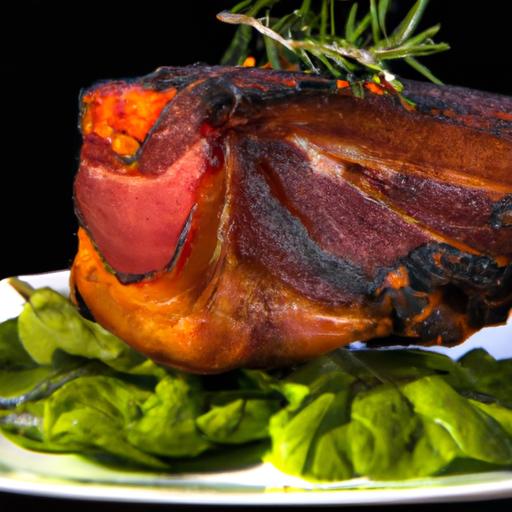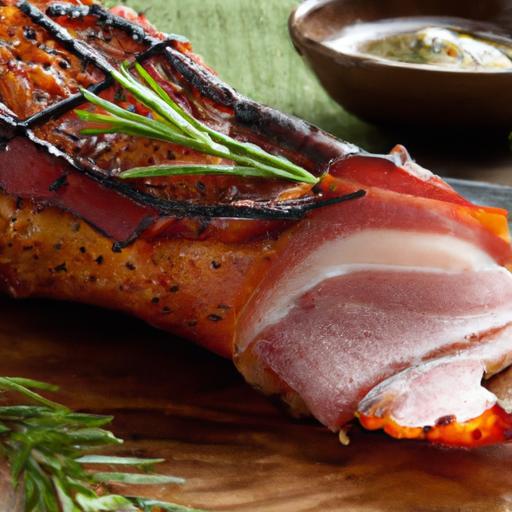There’s a timeless magic in the slow dance of smoke and fire, transforming humble cuts of meat into tender, flavor-packed masterpieces. For beginners, the world of meat smoking might seem like an ancient art woven with mystery and patience, but it’s truly a rewarding craft waiting to be mastered. In this flavorful guide, we’ll ignite your passion and walk you through the essential steps, tips, and techniques to help you unlock smoky perfection. Whether you crave the rich aroma of hickory or the subtle whisper of applewood, get ready to elevate your culinary game and become the maestro of smoke. Welcome to your first step toward mastering meat smoking!
Mastering meat smoking is an art that begins with understanding how to delicately pair the right woods with meats for enhanced flavor profiles. Imagine the warm, aromatic kiss of hickory enveloping a brisket or the subtle fruitiness of apple wood elevating pork shoulder-it’s these thoughtful combinations that transform simple proteins into unforgettable dishes.
Choosing the Perfect Wood and Meat Pairings for Ultimate Flavor
Different woods bring distinct tastes and intensities. Hickory delivers a bold, bacon-like flavor perfect for beef and pork, while mesquite is intense and slightly sweet, best reserved for red meats like steaks and ribs. For poultry and fish, milder woods such as apple and cherry infuse a fruity, subtle smoke, enhancing rather than overpowering delicate flavors. Maple offers a sweet aroma suitable for game birds and vegetables, and pecan strikes a perfect balance, pairing easily with most meats.
Start small-experiment with chunks or chips to learn which profiles excite your palate. Mixing woods can create rich, layered smoke, but be cautious; too many combinations risk confusing the flavors.
Essential Equipment and Setup Tips for Seamless Smoking Sessions
Success begins with a reliable smoker-whether offset, pellet, or charcoal-based-equipped with a built-in thermometer for precise temperature readings. Choose quality heat-resistant gloves, long-handled tongs, and a sturdy water pan to maintain moisture. Before you ignite the fire, ensure your workspace is clean, wood chips are soaked for at least 30 minutes to moderate smoke production, and your smoker grates are well-oiled to prevent sticking.
Set up your smoker in a well-ventilated area and consider a windbreak if outdoors. Position your firebox or charcoal tray opposite the meat placement for indirect heat, avoiding flare-ups that cause bitter creosote flavors.
Mastering Temperature Control and Timing for Tender, Juicy Results
Low and slow is the creed of smoking. Aim to maintain a steady 225°F to 250°F for most meats, allowing collagen to break down without drying the cut. Use a dual-probe meat thermometer-one for ambient smoker temperature, another for internal meat temp. This lets you track progress and prevent overcooking.
Plan around 1.5 to 2 hours per pound for larger cuts, but always rely on internal temperature rather than time alone. For example, brisket is done at around 200°F internal, while ribs finish at about 195°F-203°F. Patience is crucial-wrap meats in foil or butcher paper mid-way (the “Texas Crutch”) to lock moisture and speed tenderness without sacrificing bark texture.
Flavor Boosting Techniques: Rubs, Marinades, and Beyond
Rubs and marinades act as the front line of flavor infusion. Dry rubs-typically a mixture of salt, sugar, smoked paprika, garlic powder, and pepper-create a flavorful crust that seals in juices during smoking. For marinating, an acid like apple cider vinegar or citrus juice tenderizes the meat while herbs and spices pen a subtle complexity.
Don’t be afraid to experiment with layering: start with a marinade, pat dry, then apply a rub for depth. Injecting marinades directly into larger roasts can ensure juicy, flavorful bites all the way through. Finish with wood-fired spritzes-like apple juice or beer-during smoking sessions to add moisture and complimentary notes.
Prep and Cook Time
- Preparation: 45 minutes (including wood soaking and rub application)
- Cooking: 4 to 8 hours, depending on cut size and smoker setup
Yield
- Serves 6-8 hungry guests, ideal for family gatherings or weekend cookouts
Difficulty Level
- Medium – requires equipment familiarity and patience, but perfect for motivated beginners
Ingredients
- 5 lbs beef brisket or pork shoulder, trimmed
- 1/4 cup hickory wood chips, soaked 30 minutes
- 1/4 cup apple wood chips (optional for milder smoke)
- 1/4 cup kosher salt
- 1/4 cup brown sugar, packed
- 1 tbsp smoked paprika
- 1 tbsp garlic powder
- 1 tbsp onion powder
- 1 tsp black pepper, freshly ground
- 1 tsp cayenne pepper (optional for heat)
- 1/2 cup apple cider vinegar (for marinade)
- 1/4 cup olive oil
Instructions
- Prepare the meat: Trim excess fat, then combine apple cider vinegar and olive oil to marinate the brisket for 2-4 hours or overnight in the fridge.
- Make the rub: In a bowl, mix salt, brown sugar, smoked paprika, garlic powder, onion powder, black pepper, and cayenne pepper if using.
- Apply the rub: Pat the meat dry, then generously coat all sides with the dry rub, pressing it in to adhere. Let it rest at room temperature for 30 minutes before smoking.
- Preheat smoker: Light your smoker and stabilize the temperature around 225°F-250°F. Add soaked hickory and apple wood chips to the firebox or on top of charcoal for steady smoke.
- Smoke the meat: Place the brisket fat-side up on the grate away from direct heat. Close the lid and smoke until the internal temperature reaches 160°F (~4-5 hours).
- Wrap the meat: Using butcher paper or foil, wrap the brisket tightly to retain moisture, then return it to the smoker.
- Finish smoking: Continue smoking until internal temperature reaches 200°F-205°F, and the meat is tender when probed (usually another 2-3 hours).
- Rest and serve: Let the meat rest wrapped for at least 1 hour before slicing against the grain to maintain juiciness.
Tips for Success
- Maintain steady smoker temps by adjusting vents gradually-avoid rapid changes that disturb wood combustion.
- Use a water pan inside the smoker to stabilize moisture levels, preventing meat from drying out during long cooks.
- Experiment with different wood combos in small batches before committing to a full cook.
- Keep a spray bottle handy with apple juice or beer for occasional spritzing to add moisture and enhance bark formation.
- For quicker cooks, try smaller cuts like pork ribs or chicken wings but adjust timing accordingly.
Serving Suggestions
Slice your smoked brisket thin and serve atop soft, toasted buns with tangy coleslaw and a drizzle of smoky barbecue sauce for a classic sandwich experience. Alternatively, present thick slices beside slow-braised beans and pickled vegetables to balance richness with bright acidity. Garnish with fresh herbs like chopped parsley or thyme to add a vibrant touch of color and aroma.
| Nutrient | Per Serving (approx.) |
|---|---|
| Calories | 480 kcal |
| Protein | 45 g |
| Carbohydrates | 12 g |
| Fat | 26 g |
Learn more smoking essentials at Serious Eats.
Check out our guide to smoking wood types for deeper insights into flavor combinations.

Q&A
Q&A: Mastering Meat Smoking – A Beginner’s Flavorful Guide
Q1: What is meat smoking, and why is it so beloved?
A1: Meat smoking is the art of slow-cooking meat over wood smoke, infusing it with rich, deep flavors and tender textures. It’s beloved because it transforms simple cuts into soulful feasts, layering taste with smoky whispers that dance on the palate.
Q2: What types of wood should beginners use for smoking meat?
A2: For beginners, mild woods like apple, cherry, or pecan are ideal. They offer a sweet, gentle smoke that won’t overwhelm the meat. As skills develop, hickory or mesquite can add boldly smoky, robust notes for those seeking a heartier punch.
Q3: How important is temperature control in meat smoking?
A3: Temperature control is the secret spell that turns smoking into magic. Keeping a steady low heat (usually between 200-250°F) ensures the meat cooks slowly and evenly, breaking down connective tissues and allowing smoke to penetrate deeply-without turning your masterpiece into charcoal.
Q4: Can I smoke any cut of meat?
A4: Almost! Tougher cuts like pork shoulder, brisket, and ribs thrive in the slow, smoky embrace, becoming tender and luscious. Lean cuts and delicate fish can be smoked too, but they require careful timing and lighter smoke to avoid drying out or overpowering the natural flavors.
Q5: How long does it typically take to smoke meat?
A5: Patience is the smoker’s best friend. Depending on the cut and size, smoking can range from a few hours to an entire day. For instance, ribs might take 4-6 hours, while a beef brisket could leisurely bask in smoke for 10-14 hours or more, rewarding you with unforgettable juiciness.
Q6: What are some beginner-friendly tips to enhance the flavor?
A6: Start with a simple dry rub blending salt, pepper, garlic powder, and paprika. Marinades and brines add moisture and complexity. Remember to let your meat rest after smoking to lock in juices. And don’t forget-clean smoke, plenty of air, and consistent heat are your allies on this flavorful journey.
Q7: How do I know when the meat is perfectly smoked?
A7: Beyond probe thermometer temps (think 195-205°F for brisket), look for a beautiful mahogany bark, tender texture that yields to a gentle poke, and a delectable smoky aroma. Taste tests are encouraged-you’re the ultimate judge of your smoky symphony!
Q8: Is it necessary to marinade or brine before smoking?
A8: Not always, but it’s a wise technique to enhance moisture and flavor, especially for lean meats. Brining pumps in juiciness, while marinades add layers of tang and spice. Experiment to find what best sings to your taste buds.
Mastering meat smoking is a flavorful adventure-one filled with trial, patience, and delicious rewards. Embrace the smoke, and let your grill tell its smoky story.
Future Outlook
As the embers fade and the smoke curls into the evening breeze, mastering the art of meat smoking reveals itself not just as a cooking technique, but as a flavorful journey-one that transforms humble cuts into smoky masterpieces. Whether you’re tending your first brisket or experimenting with unexpected wood chips, every step deepens your connection to a timeless craft. So, fire up your smoker, embrace patience, and let each savory bite tell the story of your smoky success. Your adventure in flavor has only just begun.


